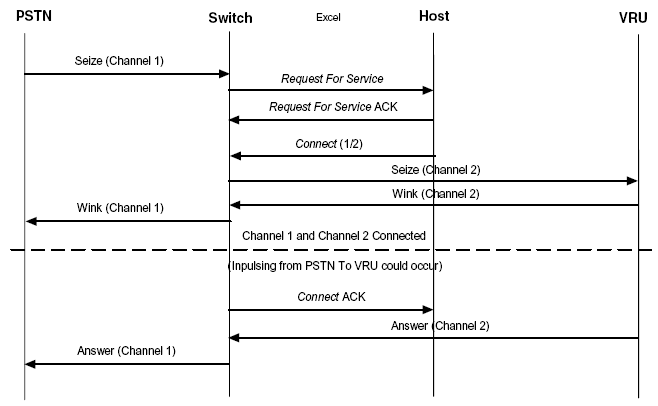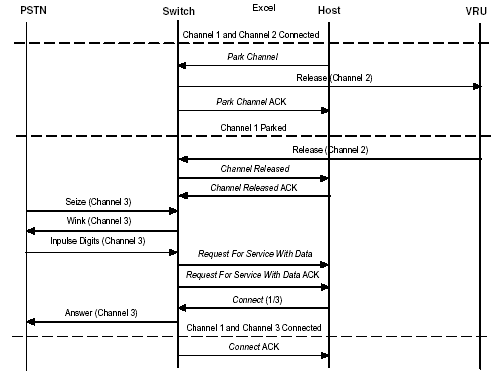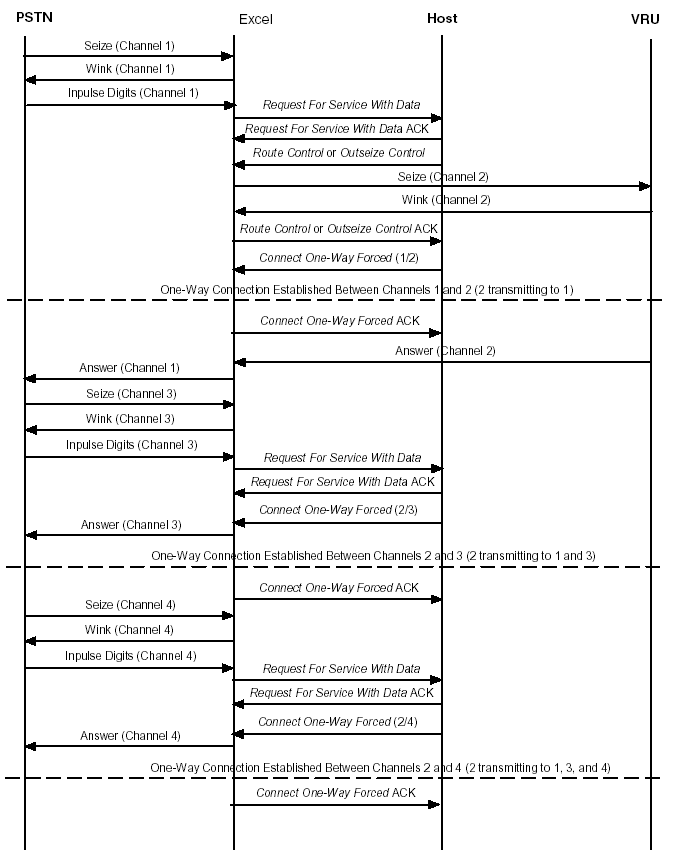
You are here: CSP Developerís Guide: Overview†>†5 Layer 4 Call Control†>†Call Control - Default Call Flows
Call Control - Default Call Flows

This section includes default call flows for various call scenarios. You can modify these call flows to suit your application needs, using the PPL programmability of Call Control.
Simple Call Cut-Through
Trunk Type: E&M Wink Start
Inseize Instructions:
1. Report Incoming Call
2. Wait for Host Control
Sequence:
1. When the CSP detects an incoming call, the CSP reports the call along with the channel ID to the host in the form of a Request for Service message.
2. The host sends a Connect message to outseize the destination channel.
3. When the outseizure ACK (Wink) is detected, the inseize ACK (Wink) is generated.
4. The connection between the two channels is now established. The terminating equipment can now collect and analyze digits.
5. When answer signaling is detected, the CSP answers the incoming call.

Park with Reconnection to an Incoming Call
This call flow shows a parked connection with a re-connection to an incoming call.
1. Channel 1 is connected to Channel 2.
2. The host issues a Park Channel message to park Channel 1.
3. The CSP parks Channel 1 and releases Channel 2.
4. The CSP processes an incoming call without host intervention.
5. This call is reported to the host along with all impulsed address digits.
6. The host sends a Connect message to connect Channels 1 and 3.
7. The CSP answers the incoming call if the parked call was previously answered, assuming that the CSP is controlling answer supervision.
8. Channel 1 is now connected to Channel 3.

Connecting a Connected Channel to an Outseized Channel
The following call flow shows a connection from a connected channel to an outseized channel.
1. Channel 1 and Channel 2 are connected.
2. The host initiates an outseizure with digit outpulsing.
3. Upon completion, the CSP returns an acknowledgment.
4. The host sends a Connect message to connect Channels 1 and 3.
5. Upon completion, the CSP sends an acknowledgment and releases Channel 2.

Broadcast with One-Way Connection
1. The CSP processes an incoming call over Channel 1.
2. The host initiates an outseizure over Channel 2.
3. Upon completion, the CSP returns an acknowledgment.
4. The host issues a Connect One-Way Forced message to the CSP, using Channel 2 as the one-way source.
5. The CSP makes the connection and returns an acknowledgment.
6. The CSP processes another incoming call over Channel 3 and reports it to the host.
7. The host again issues a Connect One-Way Forced message to the CSP, using Channel 2 as the one-way source.
8. The CSP makes the 1-way connection and returns an acknowledgment.
9. The CSP processes another incoming call over Channel 3 and reports it to the host.
10. The host issues another Connect One-Way Forced message to the CSP using Channel 2 as the one-way source.
11. The CSP makes the one-way connection and returns an acknowledgment.
